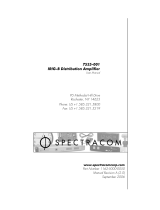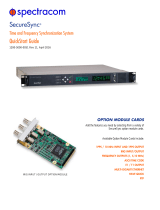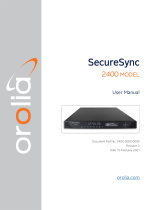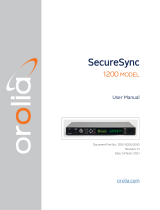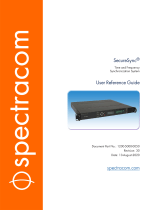Page is loading ...

Spectracom EPSILON Switch & Amplifier System SAS-E
User’s Manual 1-2
SPECTRACOM LIMITED WARRANTY
© 2009-2018 Spectracom. All rights reserved.
The information in this document has been carefully reviewed and is
believed to be accurate and up-to-date. Spectracom assumes no responsibility for
any errors or omissions that may be contained in this document, and makes no
commitment to keep current the information in this manual, or to notify any person or
organization of updates. This User Reference Guide is subject to change without
notice. For the most current version of this documentation, please see our web site
at:
spectracom.com
Spectracom reserves the right to make changes to the product described in
this document at any time and without notice. Any software that may be
provided with the product described in this document is furnished under a
license agreement or nondisclosure agreement. The software may be used
or copied only in accordance with the terms of those agreements.
No part of this publication may be reproduced, stored in a retrieval system, or
transmitted in any form or any means electronic or mechanical, including
photocopying and recording for any purpose other than the purchaser's personal use
without the written permission of Spectracom.
Other products and companies referred to herein are trademarks or
registered trademarks of their respective companies or mark holders.
Warranty Information
For a copy of Spectracom's Limited Warranty policy, see the Spectracom
website: http://spectracom.com/support/warranty-information

Spectracom EPSILON Switch & Amplifier System SAS-E
User’s Manual
1-3
TABLE OF CONTENTS
1 INTRODUCTION ................................................................................................. 1-5
1.1 Terminology ..................................................................................................................... 1-6
1.2 Inventory .......................................................................................................................... 1-6
1.3 Inspection ......................................................................................................................... 1-6
1.4 SAS17E Synoptic............................................................................................................. 1-7
1.5 SAS36E Synoptic............................................................................................................. 1-8
1.6 Dimensions and Weight ................................................................................................... 1-9
1.7 Front and Rear Panel ...................................................................................................... 1-10
1.7.1 SAS17E .......................................................................................................................... 1-10
1.7.2 SAS36E .......................................................................................................................... 1-12
2 FEATURES ........................................................................................................... 2-1
2.1 Main Power Supply.......................................................................................................... 2-1
2.2 DC Power Supply ............................................................................................................ 2-1
2.2.1 Previous Material revision typically delivered before July 2017 .................................... 2-1
2.2.2 Material revision typically delivered before July 2017 ................................................... 2-2
2.2.3 Information for parts not included in the product package : ............................................ 2-3
2.3 Input Signals .................................................................................................................... 2-4
2.4 Output Signals .................................................................................................................. 2-5
2.5 Urgent Alarm or Major Alarm ......................................................................................... 2-6
2.6 Non-Urgent Alarm or Minor Alarm ................................................................................ 2-6
2.7 Ethernet Port .................................................................................................................... 2-7
2.8 Operating Environment .................................................................................................... 2-7
2.9 EMC ................................................................................................................................. 2-7
3 INSTALLATION ................................................................................................... 3-1
3.1 Powering Up .................................................................................................................... 3-1
3.2 Network Connection ........................................................................................................ 3-1
3.3 Configuring and Operating the SAS-E ............................................................................ 3-2
3.4 Status of the SAS-E ......................................................................................................... 3-4
3.4.1 Status LED ....................................................................................................................... 3-4
3.5 Alarm ............................................................................................................................... 3-5
3.6 Powering Down ............................................................................................................... 3-6
4 WEB INTERFACE................................................................................................. 4-1
4.1 Web Pages ........................................................................................................................ 4-1
4.1.1 Welcome Page ................................................................................................................. 4-1
4.1.2 Upper Task Bar and Page Header .................................................................................... 4-2
4.1.3 SAS-E Status .................................................................................................................... 4-3
4.1.4 Admin Password Page ..................................................................................................... 4-7
4.1.5 Network Setup Page ......................................................................................................... 4-8
4.1.6 SNMP and Traps Setup Page ........................................................................................... 4-9
4.1.7 SAS-E Configuration ..................................................................................................... 4-12
4.1.8 Tools .............................................................................................................................. 4-14

Spectracom EPSILON Switch & Amplifier System SAS-E
User’s Manual 1-4
5 SNMP CONTROL ............................................................................................... 5-1
5.1 MIB Content .................................................................................................................... 5-1
5.2 SNMP Traps..................................................................................................................... 5-2
6 MAINTENANCE ................................................................................................. 6-1
6.1 Updating the Software Version ........................................................................................ 6-1

Spectracom EPSILON Switch & Amplifier System SAS-E
User’s Manual
1-5
1
Introduction
This document is the User’s Manual for the EPSILON Switch and Amplifier System 17E and the
EPSILON Switch and Amplifier System 36E. (Unless otherwise indicated, details contained
herein apply to both models.)
The SAS-E achieves redundant Time & Frequency source monitoring with intelligent and
automatic switching. It amplifies signals from the selected source and offers a large quantity of
output channels. The SAS-E receives, and monitors continuously, signals from 1 or 2 external
clocks:
• Frequency sine wave signal (from 1 MHz up to 16 MHz)
• IRIG B DCLS or 1 pulse per second time synchronization (1PPS/DCLS TTL/50Ω)
• Time Of Day message (RS232C serial line)
• External clock status (relay contact)
• External signals* (External Sig)
Monitoring results (lost signal and minimal period detection) are reported to the user through
dedicated LEDs and through an Ethernet port. When 2 external clocks are connected, the
SAS-E offers a powerful redundant function by selecting, automatically, the better source. This
automatic selection may be by-passed by the user to allow maintenance or for single clock
operation.
In all cases, the distributed signals — Frequency, 1 Pulse Per Second (PPS), Time of Day
(ToD) — are issued from the same source clock. In automatic mode, when the current selected
source is detected faulty, the SAS-E switches all the distributed signals to the other source. An
Ethernet port allows managing and controlling the SAS-E through embedded SNMP protocol
and/or web server.
The SAS-E is available in two heights to adapt the output capacity to the user’s requirements:
SAS17E — 1u High Version:
8 x frequency outputs, 8 x 1PPS/DCLS TTL outputs, 2 x ToD outputs, 2 x external signals.
SAS36E — 2u High Version:
16 x frequency outputs, 16 x 1PPS/DCLS TTL outputs, 2 x ToD outputs, 2 x external signals.
*This External Signal input : this feature can only do the redundancy function, not multiply the distributed
signal.
Example : you can input 2 x IRIG RS485 and output 1 x IRIG RS485 with redundancy.
Note about the limitation of this feature : this signal input is not monitored by SAS E (SAS E doesn’t
analyze the presence nor the quality of the “External Sig” input signal to use it as criteria for switching).
So if you want to make the SAS E switches, you will need to use other inputs in addition (like alarm
contact or 1PPS/10MHz or RS232/TOD signal input).

Spectracom EPSILON Switch & Amplifier System SAS-E
User’s Manual 1-6
1.1
Terminology
DHCP Dynamic Host Configuration Protocol
IP Internet Protocol
MIB Management Information Base
NTP Network Time Protocol
OID Objet IDentifier
PPS Pulse Per Second
SAS Switch & Amplifier System
SNMP Single Network Management Protocol
ToD Serial message Time of Day
USB Universal Serial Bus
1.2
Inventory
Before installing your Spectracom product, please verify that all material ordered has been
received. If there is a discrepancy, please contact Spectracom Customer Service. Customer
service is available by telephone at +33 (0) 1.64.53.39.80 (France), or +1.585.321.5800 (United
States). Updated contacts information are available on web site, see “Support” page.
CAUTION: Electronic equipment is sensitive to Electrostatic
Discharge (ESD). Observe all applicable ESD
precautions and safeguards when handling the
Spectracom equipment.
NOTE: If equipment is returned to Spectracom, it must be shipped in its original packing
material. Save all packaging material for this purpose.
1.3
Inspection
Unpack the equipment and inspect it for damage. If any equipment has been damaged in
transit, please contact Spectracom Customer Service. Customer service is available by
telephone at +33 (0) 1.64.53.39.80 (France), or +1.585.321.5800 (United States). Updated
contacts information are available on web site, see “Support” page.

Spectracom EPSILON Switch & Amplifier System SAS-E
User’s Manual
1-7
1.4
SAS17E Synoptic
Note about ports :
1 pps port (input or output) : Can be used for 1PPS TTL level or IRIG B DCLS (TTL)
signals.
Freq port (input or output) : Use Frequency sine wave signal only (from 1 MHz up to 16
MHz).
Ext Sig : see details on chapter 2.3
Alarm : Urg (can be named MAJ depending version) Non Urg (can be named Min
depending version).
GPS antenna
External Clock
(A source )
Source selection & switching
Alarm
ToD
8 x Freq
Switch
and
Amplifier
System
GPS antenna
External Clock
(B source)
8 x 1 pps
Output amplification
& distribution
Signal
Monitoring
230 Vac
24 Vdc
Redundant
Power
Supply
F
r
e
q
A
1
s
A
p
p
T
o
D
A
A
l
a
r
m
A
F
r
e
q
1
p
p
s
T
o
D
E
x
t
s
A
i
g
x2
E
x
t
s
B
i
g
x2
F
r
e
q
B
1
s
B
p
p
T
o
D
B
A
l
a
r
m
B
E
x
t
s
i
g
x2
Ext. Sig.
x2
urg
Alarm
non urg
Ethernet
port
Vac
Vdc
Ext. Sig.
2xToD

Spectracom EPSILON Switch & Amplifier System SAS-E
User’s Manual 1-8
1.5
SAS36E Synoptic
Note about ports :
1 pps port (input or output) : Can be used for 1PPS TTL level or IRIG B DCLS (TTL)
signals.
Freq port (input or output) : Use Frequency sine wave signal only (from 1 MHz up to 16
MHz).
Ext Sig : see details on chapter 2.3
Alarm : Urg (can be named MAJ depending version) Non Urg (can be named Min
depending version)
GPS antenna
External Clock
(A source )
Source selection & switching
Alarm
ToD
8 x Freq
Switch
and
Amplifier
System
GPS antenna
External Clock
(B source)
8 x 1 pps
Output amplification
& distribution
Signal
Monitoring
230 Vac
24 Vdc
Redundant
Power
Supply
F
r
e
q
A
1
s
A
p
p
T
o
D
A
A
l
a
r
m
A
F
r
e
q
1
p
p
s
T
o
D
E
x
t
s
A
i
g
x2
E
x
t
s
B
i
g
x2
F
r
e
q
B
1
s
B
p
p
T
o
D
B
A
l
a
r
m
B
E
x
t
s
i
g
x2
Ext. Sig.
x2
urg
Alarm
non urg
Ethernet
port
Vac
Vdc
Ext. Sig.
2xToD
16
16

Spectracom EPSILON Switch & Amplifier System SAS-E
User’s Manual
1-9
1.6
Dimensions and Weight
SAS17E
1u version
SAS36E
2u version
Height
43.6 mm ±0.1mm
88.1 mm ±0.1mm
Width
483 mm ±0.1mm
483 mm ±0.1mm
Depth
323 mm ±0.1mm
323 mm ±0.1mm
Weight
3.2 kg
4.1 kg
Mechanical Installation – Rack mounting
The holes can be used to adapt rackmount slides. (see dimension below for detail)
Please note that screws must be M4 x 8 max length (depth accepted inside the box).

Spectracom EPSILON Switch & Amplifier System SAS-E
User’s Manual
1-10
1.7
Front and Rear Panel
1.7.1 SAS17E
Versions delivered before July 2017

Spectracom EPSILON Switch & Amplifier System SAS-E
User’s Manual
1-11
Versions delivered after July 2017 :

EPSILON Switch & Amplifier System E Spectracom
User’s Manual
1-12
1.7.2 SAS36E
Versions delivered before July 2017

Spectracom EPSILON Switch & Amplifier System SAS-E
User’s Manual
1-13
Versions delivered after July 2017 :


Spectracom EPSILON Switch & Amplifier System E
User’s Manual
2-1
2
Features
2.1
Main Power Supply
Main power connector CCE22 with ON/OFF switch.
Input voltage: MAINS 100V-240V 50Hz-60Hz 0.6 A
Fuses: FUS. 2 x T 1A L 250V
Consumption: 18 W typical
Example (recommended by Spectracom ) : ref SCHURTER FST 5x20 type - Miniature Fuse, 5
x 20 mm, Time-Lag T, L, 250 VAC (REF 0034.3117)
Detection of power input presence on AC/DC converter — information available with remote
control software.
2.2
DC Power Supply
Input power (VDC): 24 to 48V
Consumption: < 50 W typical.
Protection against polarity inversion.
Protection against short-circuit: polyswitch ensures the isolation of the module in relation to the
DC power supply in the event of a short-circuit of the EPSILON’s power supply.
Detection of power input presence on AC/DC converter — information available with remote
control software.
Two configurations can be found depending versions :
2.2.1 Previous Material revision typically delivered before July 2017
Connector: DC POWER XLR 3 points pins male NEUTRIX reference NC3MDH
Pins settings:
Pin Number:
1 +VDC
2 -VDC
3 Earth Ground

EPSILON Switch & Amplifier System E Spectracom
User’s Manual
2-2
The power supply must be connected between pins 1 and 2, rear panel external view:
2.2.2 Material revision typically delivered before July 2017
Connector: DC Plug, 3-pin, chassis mount: Amphenol P/N DL3102A10SL-3P
Note : Connection is equal to SecureSync units.
Pinout description, DC connector
• Pin B goes to the most positive DC voltage of the DC source. For +24/48 V this would be
the positive output from the DC source. For a -24/48 VDC source this would be the
ground or return of the DC source.
• Pin A goes to the most negative voltage of the DC source. For +24/48 V this would be
the ground or return output from the DC source. For a -24/48 VDC source this would
be the negative output from the DC source.
• Pin C goes to the Earth ground of the DC source.
Pin 3
Earth
Pin 2
-VDC
Pin 1
VDC

Spectracom EPSILON Switch & Amplifier System E
User’s Manual
2-3
2.2.3 Information for parts not included in the product package :
• Mating DC Connector, circular, 3-pin, solder socket, 16AWG,13A,300V: Amphenol P/N
DL3106A10SL-3S. (same as used by SecureSync)
• AC/DC converter: With recent version using Amphenol type*, the DC input can be used
as a second AC input: As an option, Spectracom offers a kit containing an AC/DC
converter with a pre-assempled DC connector: The part number for this adaptor kit is
PS06R-2Z1M-DT01. (same as for SecureSync unit).
*Note : For SAS-E versions delivered before July 2017, the AC/DC converter reference is
PS06R-2Z1M-DT03.

EPSILON Switch & Amplifier System E Spectracom
User’s Manual
2-4
2.3
Input Signals
Connector
ESAS
Electrical Characteristics
Frequency_In
external clock A
J1
BNC Female:
- Core: Sine-wave signal
Frequency: 1MHz up to 16MHz
Level : 0dBm up to +17dBm
- Braid: electrical ground
Frequency_In
external clock B
J26
1PPS_In
external clock A
J2
BNC Female:
- Core: periodic pulse
period : 1s
High Level: > 2.4V load 50 Ω
low Level : < 0.7V load 50 Ω
- Braid: electrical ground
1PPS_In
external clock B
J25
ToD_In
external clock A
J3
Mini Din 6 pins Female:
Pin number:
1: Reserved (see Ext Signal) 4: Electrical ground
2: Reserved (see Ext Signal) 5: Message input(*)
3: NC 6: Electrical ground
ToD_In
external clock B
J24
(*): level RS232C, ASCII message
ALARM_In
external clock A
J4
Jack 3,5mm Mono Female:
Input for open collector (current drive: 0,5mA) or
for relay contact
Braid: Electrical ground
ALARM_In
external clock B
J23
External Signals_In
external clock A
J3
Mini Din 6 pins Female:
Pin number:
1: External_signal 1(ext -) 4: Electrical ground
2: External_signal 2(ext +) 5: Reserved
3: NC 6: Electrical ground
Characteristic: 12VDC/2A max / 100VAC/1A Max.
External Signals_In
external clock B
J24
This feature can only do the redundancy function, not multiply the distributed signal.
Example : you can input 2 x IRIG RS485 and output 1 x IRIG RS485 redunded.
Note about the limitation of this feature : signal input is not monitored by SAS E (SAS E
doesn’t analyze the presence nor the quality of the “External Sig” input signal to use it as
criteria for switching). So if you want to make the SAS E switches, you will need to use other
inputs (like alarm contact or 1PPS/10MHz or RS232 signal input).
Chassis panel view
J3,J24 INPUT CONNECTORS

Spectracom EPSILON Switch & Amplifier System E
User’s Manual
2-5
2.4
Output Signals
Connector
SASE17
Connector
SASE36
Electrical characteristics
Frequency_Out
J6 , J7 , J8,
J9, J10, J11,
J12, J13
J6 , J7 , J8,
J9, J10, J11,
J12, J13,
J14, J15, J16
J17, J18, J19
J20, J21
BNC Female:
- Core: Sine-wave signal
if external clock A selected: J2 input frequency
J2 input level ± 10%
if external clock B selected: J25 input frequency
J25 input level ± 10%
- Braid: electrical ground
1PPS_Out
J14, J15, J16
J17, J18, J19
J20, J21
J27, J28, J29,
J30, J31, J32,
J33, J34
J35, J36, J37,
J38, J39, J40,
J41, J42
BNC Female:
- Core: Periodic pulse
if external clock A selected: J1 input periodic pulse
if external clock B selected: J26 input periodic pulse
High Level: > 2.4V load 50 Ω
Low Level : < 0.7V load 50 Ω
- Braid: electrical ground
ToD_Out
J5, J22
J5, J22
Mini Din 6 pins Female:
Pin number:
1: Reserved (see Ext Signal)
2: Reserved (see Ext Signal)
3: Electrical ground
4: NC
5: Electrical ground
6: if external clock A selected: J3 input ToD (RS232C)
if external clock B selected: J24 input ToD (RS232C)
External
Signals_Out
J5, J22
J5, J22
Mini Din 6 pins Female:
Pin number:
1: if external clock A selected: J3 input External_signal 1 (ext +)
if external clock B selected: J24 input External_signal 1 (ext +)
2: if external clock A selected: J3 input External_signal 2 (ext -)
if external clock B selected: J24 input External_signal 2 (ext -)
3: Electrical ground
4: NC
5: Electrical ground
6: Reserved
Chassis panel view
J5,J22 OUTPUT CONNECTORS

EPSILON Switch & Amplifier System E Spectracom
User’s Manual
2-6
2.5
Urgent Alarm or Major Alarm
Connector: Universal Serial Bus (USB) connector A series (URG)
Pin
Signal
Description
1
Urg_al_ closed +
Urgent Alarm active closed contact +
2
Urg_al_ closed -
Urgent Alarm active closed contact -
3
Urg_al_ open +
Urgent Alarm active open contact +
4
Urg_al_ open -
Urgent Alarm active open contact -
Characteristics:
- Relay contact
- Pin 1 and 2 closed in case of urgent alarm active
- Pin 3 and 4 open in case of urgent alarm active
- Resistive contact Rating: 30VA / 250V
2.6
Non-Urgent Alarm or Minor Alarm
Connector: Universal Serial Bus (USB) connector A series (NURG)
Pin
Signal
Description
1
Nurg_al_ closed +
Non Urgent Alarm active closed contact +
2
Nurg_al_ closed -
Non Urgent Alarm active closed contact -
3
Nurg _al_ open +
Non Urgent Alarm active open contact +
4
Nurg _al_ open -
Non Urgent Alarm active open contact -
Caution to add : not to be used as a standard USB port etc…..
Characteristics:
- Relay contact
- Pin 1 and 2 closed in case of urgent alarm active
- Pin 3 and 4 opened in case of urgent alarm active
- Resistive contact Rating: 30VA / 250V
URG or Maj
NURG
Or
Min
/

